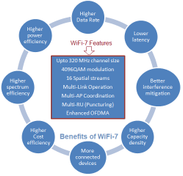RF Phase Noise Measurement and Test Setup using Spectrum Analyzer
Advertisement
Introduction
RF phase noise measurement is essential for analyzing the stability of oscillators and signal sources in RF systems. Phase noise affects the quality of communication links, radar performance, and signal processing accuracy. Test setups typically involve phase noise analyzers, spectrum analyzers, and low-noise reference oscillators for precise evaluation. This guide delves into the techniques, tools, and practical steps required to accurately measure phase noise and enhance RF system performance.
Phase noise measurement is crucial in characterizing the performance of RF (Radio Frequency) oscillators and signal sources. Phase noise refers to the short-term fluctuations in the phase of a signal, typically expressed in units of dBc/Hz (decibels relative to the carrier per Hz bandwidth). An RF spectrum analyzer is commonly used to measure phase noise. Let’s explore phase noise measurement using an RF spectrum analyzer.
Let us understand Phase noise test set up used for its measurement with a spectrum analyzer. As we know phase noise is the measurement which helps in verifying the purity of the RF signal under test. It is measured for various RF components, devices and systems which include crystal oscillator, Local Oscillator, Synthesizer, Up/Down Frequency converters etc.
Phase Noise is specified as follows: “Phase Noise is equal to -60dBc/Hz at 1KHz” for RF synthesizer output of 6 GHz.
How to Measure Phase Noise with a Spectrum Analyzer
Here’s an explanation of the test setup and process.
Test Setup
-
RF Signal Source (DUT): The first component of the setup is the RF signal source, which is the device under test (DUT). This could be a signal generator, a frequency synthesizer, an oscillator, or any other RF device that generates a signal. The signal source should have stable frequency and amplitude characteristics.
-
Frequency Reference: To accurately measure phase noise, a stable frequency reference is necessary. This reference ensures that the analyzer and the DUT are both operating at the same frequency. A high-quality frequency reference, such as a precision oscillator or an atomic clock, is typically used for this purpose.
-
RF Spectrum Analyzer: The key instrument in the setup is the RF spectrum analyzer. This device is capable of measuring the amplitude of signals across a range of frequencies. It provides a graphical representation of the signal spectrum, showing the amplitude (power) of the signal as a function of frequency.
-
Phase Noise Measurement Software: Some modern spectrum analyzers come with specialized phase noise measurement software. This software is designed to accurately analyze and quantify phase noise characteristics from the spectrum analyzer’s measurements.

Figure-1: Phase noise measurement test set up using spectrum analyzer
Figure 1 depicts a typical setup used for RF phase noise measurement. As shown in the figure, the RF output of the DUT (Device Under Test), say an RF synthesizer, is connected to the RF INPUT of the Spectrum Analyzer.
The following settings need to be configured in the spectrum analyzer to measure phase noise with optimum accuracy for the above specification:
- Center Frequency (Fc): 6 GHz
- Span: 10 KHz
- Marker (δ): 1 KHz
- RBW (Resolution Bandwidth): 100 Hz
- VBW (Video Bandwidth): 1 KHz (Check the display and set accordingly to obtain the desired result).

Figure-2: Phase noise measurement
As shown in the figure, RBW has a great effect on RF phase noise measurement using a Spectrum Analyzer. Hence, the optimum RBW is selected for the best measurement corresponding to RF output and span.
Phase Noise Test Procedure
The following steps are followed for phase noise measurement:
-
Configure the signal source and spectrum analyzer to operate at the desired frequency, as mentioned in the example above.
-
Calibrate the spectrum analyzer to measure signal amplitude accurately. Do appropriate settings of RBW and VBW, as mentioned in the example above.
-
Connect the output of the RF signal source to the input of the spectrum analyzer.
-
Set the spectrum analyzer to display a narrow frequency span around the carrier frequency of the signal.
-
Enable the phase noise measurement function on the spectrum analyzer or use dedicated phase noise measurement software.
-
Initiate the measurement and allow the spectrum analyzer to capture and analyze the phase noise characteristics of the signal.
-
The spectrum analyzer will display the phase noise profile of the signal, typically in units of dBc/Hz.
Conclusion
Understanding RF phase noise and its impact is vital for optimizing oscillator performance in RF systems. Accurate measurement using advanced equipment ensures precise analysis and improved signal stability. By mastering these techniques, engineers can design and maintain reliable RF systems for various applications.
Advertisement
 RF
RF


